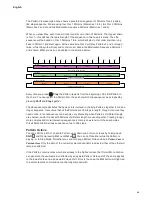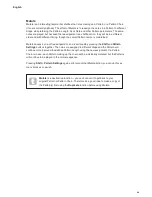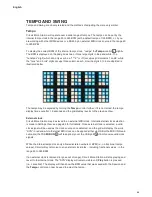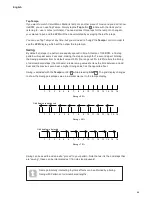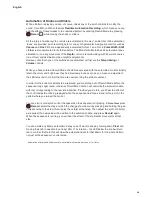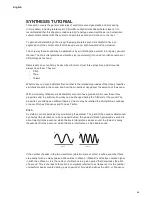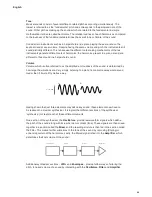
45
English
To reset the Mod Seq value to zero at a particular Step, hold
Clear
13
and press the pad in
the Pattern Step display for the Step; the Mod parameter display on the upper two rows will go
dark.
Remember that Mod Seq will have no effect on the sound unless it is assigned in the
Modulation Matrix, and the
Depth
control is turned up or, in most cases, down (either way, the
LED should be lit orange). Consider
Depth
as a scaling control for the Mod Seq values you
have assigned, just like the Mod Wheel on other synths.
Smooth
Because Mod Seq parameter values are effectively assigned in increments of 8, there will
always be a “jump” in the amount of modulation that is being applied to the chosen destination
when subsequent Pattern Steps have different Mod Seq values. This jump will obviously be
amplified when different Mod Seq values are assigned to adjacent Steps.
The effect of this on the sound may be negligible - or even inaudible; or it may be a bit
annoying. To overcome this, you can engage Smooth Mode, by pressing
Shift
and
Mod Seq
together. This interpolates between the discrete Mod Seq values, and causes the modulation to
change value gradually between steps, minimising the jump.
Note that the glide introduced by Smooth Mode has a fixed rate, and thus at higher tempos
and sync rates, the modulation depth at the next Pattern step may not have time to reach the
desired value.
When Smooth is active, the
Mod Seq
button will light bright white when
Shift
is pressed; when
Smooth is Off, the
Mod Seq
button will be dim white when
Shift
is pressed.
Recording a Pattern in real time
To record a Pattern in real time, first select a Patch. Enter
Note View
for Oscillator 1 (press
Note
and then
Osc 1
if not already selected) and run the pattern by pressing
Play.
If you want your notes to extend over four octaves rather than two (or two rather than one if
you’ve selected Chromatic scale), select
Expanded Note View
instead (
Shift
+
Note
). You can
“audition” the notes simply by playing the pads – they won’t be recorded until you press a step
button as well.
When you’re ready to save them to the pattern, press
Record
and carry on playing; after the
pattern has completed 16 steps, the notes will be replayed.
While you’re in Record, the step cursor (normally white) changes to red as it progresses
through the pattern as an additional reminder that you are now about to alter the pattern. The
Mixer level controls for Osc 1 and Osc 2 also turn red.
Once you’ve played the required notes, press
Play
again to stop recording and to halt the
sequencer.
You can also delete or add notes “manually” – that is, while the Pattern isn’t running. If you’re
working to a fast tempo, this is often easier.
Содержание Circuit Mono Station
Страница 1: ......
Страница 93: ...93 English...























